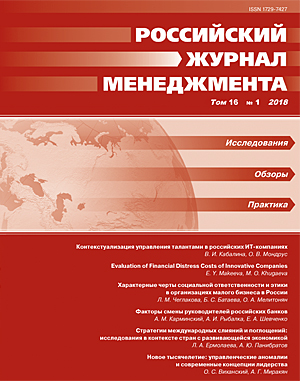Стратегии международных слияний и поглощений: исследования в контексте стран с развивающейся экономикой
DOI:
https://doi.org/10.21638/11701/spbu18.2018.105Аннотация
В статье представлен анализ теоретических подходов и результатов эмпирических исследований международных слияний и поглощений (M&A) компаний из стран с развивающейся экономикой. Несмотря на широкую дискуссию о необходимости развития более свежих идей для объяснения феномена зарубежной экспансии компаний из стран с развивающейся экономикой, было предпринято лишь несколько попыток создания новых теорий, так и не получивших широкого применения в области международного и стратегического менеджмента. Доминирующими в изучении зарубежных M&A по-прежнему остаются ресурсный подход, институциональный подход и OLI-парадигма Дж. Даннинга. В работе выделен ряд проблемных и малоизученных тем в области международных M&A, предложены направления будущих исследований в этой области в контексте стран с развивающейся экономикой.
Ключевые слова:
зарубежные M&A, страны с развивающейся экономикой, теоретические подходы, МНК, Россия
Скачивания
Библиографические ссылки
Translation of references in Russian into English
Загрузки
Опубликован
Как цитировать
Выпуск
Раздел
Лицензия
Статьи журнала «Российский журнал менеджмента» находятся в открытом доступе и распространяются в соответствии с условиями Лицензионного Договора с Санкт-Петербургским государственным университетом, который бесплатно предоставляет авторам неограниченное распространение и самостоятельное архивирование.





